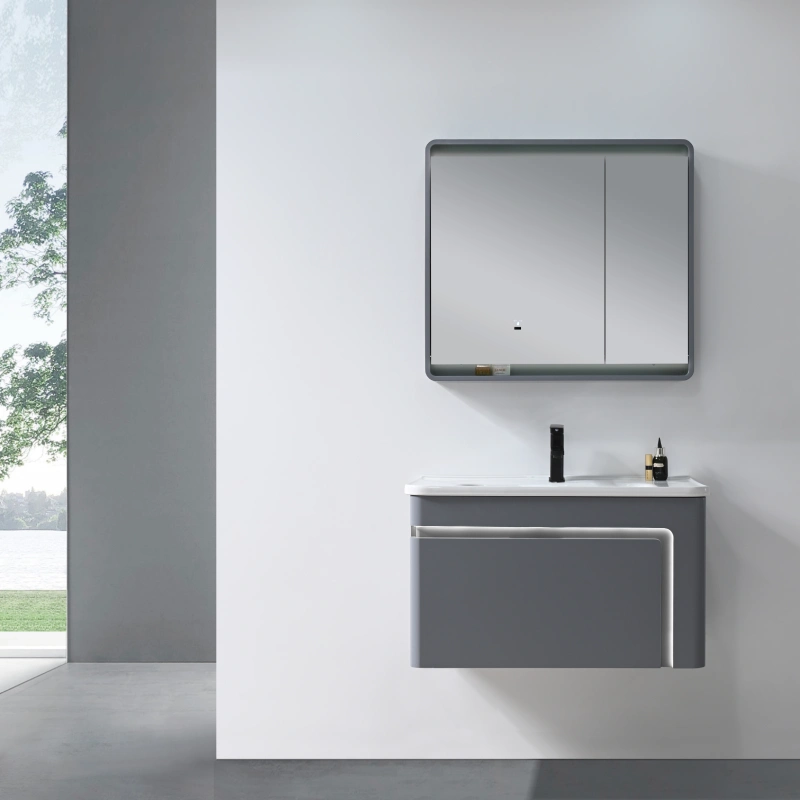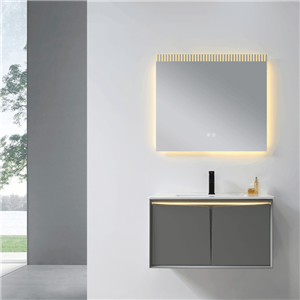How to Protect Wood Bathroom Cabinets?
Wood bathroom cabinets are a beautiful and functional addition to any bathroom. However, they require proper care and maintenance to ensure they last long and stay in good condition. In this blog post, we will explore various ways to protect your wood bathroom cabinets from damage, keep them looking new, and ensure they serve you well for years to come.
1.What Causes Damage to Wood Bathroom Cabinets?
Wood bathroom cabinets can be damaged by several factors. Understanding these causes can help you take preventive measures to protect your cabinets.
Common Causes of Damage
Moisture: Bathrooms are naturally moist environments. Water can seep into the wood, causing it to swell, warp, or rot.
Temperature Fluctuations: Extreme changes in temperature can cause wood to expand and contract, leading to cracks and splits.
Chemical Cleaners: Harsh cleaning products can strip the wood of its natural oils and finish, leaving it vulnerable to damage.
Physical Impact: Knocks, bumps, and scratches can damage the surface of the wood, making it look worn and aged.
Preventive Measures
To protect your wood bathroom cabinets from these common causes of damage, follow these preventive measures:
Keep the Bathroom Well-Ventilated: Use exhaust fans or open windows to reduce moisture levels.
Use Protective Mats: Place mats around the sink and tub to catch water spills.
Avoid Harsh Cleaners: Use gentle, wood-friendly cleaning products.
Handle with Care: Be mindful of how you use and clean the cabinets to avoid physical damage.
2. How to Properly Seal Your Wood Bathroom Cabinet
Sealing your wood bathroom cabinet is one of the best ways to protect it from moisture and other damaging elements. Here’s a step-by-step guide on how to do it.
Step-by-Step Guide to Sealing Wood Cabinets
Clean the Surface: Before applying a sealant, clean the cabinet thoroughly. Use a mild soap and water solution to remove dirt and grime.
Sand the Wood: Lightly sand the surface to create a smooth base for the sealant. Wipe away any dust with a damp cloth.
Choose the Right Sealant: There are various types of sealants available, such as polyurethane, lacquer, and varnish. Choose one that suits your needs.
Apply the Sealant: Using a brush or a cloth, apply a thin layer of sealant to the cabinet. Follow the grain of the wood for an even application.
Let It Dry: Allow the sealant to dry completely, following the manufacturer’s instructions. This usually takes a few hours.
Sand and Reapply: For best results, sand the surface lightly again and apply a second coat of sealant. This ensures maximum protection.
Benefits of Sealing
Sealing your wood bathroom cabinets offers several benefits:
Moisture Protection: Prevents water from penetrating the wood.
Enhanced Durability: Protects the wood from everyday wear and tear.
Improved Appearance: Gives the wood a shiny, polished look.
3. What are the Best Cleaning Products for Wood Bathroom Cabinets?
Using the right cleaning products is crucial for maintaining the beauty and longevity of your wood bathroom cabinets. Here’s a list of recommended products and how to use them.
Recommended Cleaning Products
| Product Type | Examples | Benefits |
|---|---|---|
| Mild Soap Solution | Dish soap and water | Gentle on wood, removes dirt |
| Wood Cleaner | Murphy Oil Soap, Pledge | Specifically designed for wood surfaces |
| Natural Cleaners | Vinegar and water solution | Eco-friendly, safe for wood |
How to Use Cleaning Products
Mild Soap Solution: Mix a few drops of dish soap with warm water. Use a soft cloth to wipe down the cabinet, then dry with a clean towel.
Wood Cleaner: Follow the instructions on the product label. Typically, you’ll spray the cleaner onto the wood and wipe it off with a soft cloth.
Natural Cleaners: Mix equal parts vinegar and water. Dampen a cloth with the solution and wipe the cabinet. Dry thoroughly afterward.
Tips for Cleaning Wood Cabinets
Regular Dusting: Dust your cabinets regularly to prevent dirt buildup.
Avoid Excess Water: Never soak the wood; always use a damp cloth and dry immediately.
Test First: Before using any new product, test it on a small, hidden area to ensure it doesn’t damage the finish.
4. How to Prevent Mold and Mildew on Wood Bathroom Cabinets
Mold and mildew thrive in damp environments like bathrooms. Here are some effective ways to prevent them from growing on your wood bathroom cabinets.
Tips to Prevent Mold and Mildew
Maintain Good Ventilation: Ensure your bathroom is well-ventilated by using exhaust fans or opening windows. This reduces moisture levels.
Use a Dehumidifier: A dehumidifier can help keep the air dry and prevent mold growth.
Regular Cleaning: Clean your cabinets regularly to remove any spores before they can grow into mold.
Keep Cabinets Dry: Wipe down your cabinets after using the bathroom to remove any excess moisture.
Cleaning Mold and Mildew
If you already have mold or mildew on your wood bathroom cabinets, here’s how to clean it safely:
Mix a Cleaning Solution: Combine one part vinegar with two parts water.
Apply the Solution: Dampen a cloth with the solution and wipe down the affected area.
Scrub Gently: Use a soft brush to scrub any stubborn spots.
Dry Thoroughly: After cleaning, dry the area completely to prevent further mold growth.
5. How Often Should You Inspect and Maintain Your Wood Bathroom Cabinet?
Regular inspection and maintenance are key to keeping your wood bathroom cabinets in top condition. Here’s how often you should perform these tasks and what to look for.
Recommended Maintenance Schedule
| Task | Frequency |
|---|---|
| Dusting | Weekly |
| Cleaning | Bi-weekly |
| Inspecting for Damage | Monthly |
| Sealing | Annually or as needed |
| Deep Cleaning | Every 6 months |
What to Look For During Inspections
Moisture Damage: Check for signs of swelling, warping, or rot.
Scratches and Dents: Look for any physical damage to the surface.
Mold and Mildew: Inspect for any signs of mold growth.
Finish Wear: Check if the sealant or finish is wearing off and needs reapplication.
Steps for Regular Maintenance
Dusting and Cleaning: Follow the cleaning tips mentioned earlier to keep your cabinets clean and dust-free.
Addressing Damage: Repair any scratches or stains as soon as you notice them.
Reapplying Sealant: If you notice the finish wearing off, reapply a sealant to protect the wood.
6.What Are the Long-Term Benefits of Protecting Your Wood Bathroom Cabinet?
Taking the time to protect and maintain your wood bathroom cabinets has numerous long-term benefits. Here’s why it’s worth the effort.
Benefits of Protection
Increased Longevity: Proper care ensures your cabinets last longer, saving you money on replacements.
Maintained Appearance: Regular maintenance keeps your cabinets looking new and attractive.
Cost Savings: By preventing damage, you avoid costly repairs and replacements.
Enhanced Value: Well-maintained cabinets add value to your home.
Summary of Protective Measures
Regular Cleaning and Dusting: Keeps your cabinets free of dirt and grime.
Proper Sealing: Protects the wood from moisture and wear.
Timely Repairs: Fixing scratches and stains promptly prevents further damage.
Preventing Mold and Mildew: Ensures a healthy and mold-free environment.





